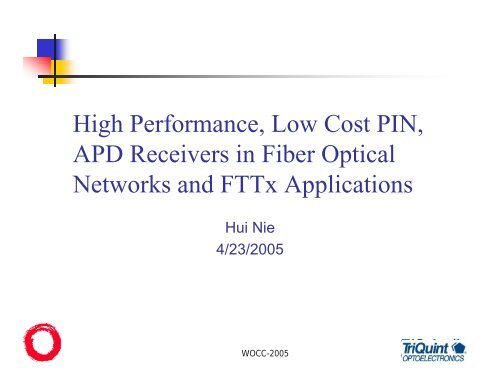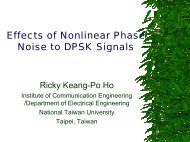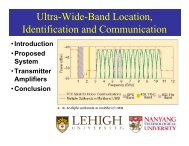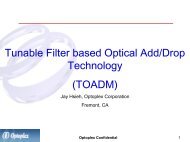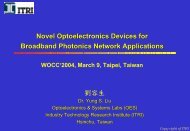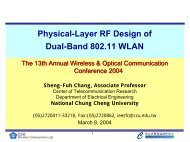High Performance, Low Cost PIN, APD Receivers in Fiber Optical ...
High Performance, Low Cost PIN, APD Receivers in Fiber Optical ...
High Performance, Low Cost PIN, APD Receivers in Fiber Optical ...
You also want an ePaper? Increase the reach of your titles
YUMPU automatically turns print PDFs into web optimized ePapers that Google loves.
<strong>High</strong> <strong>Performance</strong>, <strong>Low</strong> <strong>Cost</strong> <strong>PIN</strong>,<br />
<strong>APD</strong> <strong>Receivers</strong> <strong>in</strong> <strong>Fiber</strong> <strong>Optical</strong><br />
Networks and FTTx Applications<br />
Hui Nie<br />
4/23/2005<br />
WOCC-2005
Receiver Applications<br />
•Back Bone Core Nodes LR and VLR Interface Cards<br />
•Metro Transport L<strong>in</strong>e Cards<br />
•Metro Access L<strong>in</strong>e<br />
Cards (ADM’s)<br />
Long-Haul<br />
Backbone<br />
Metropolitan<br />
Backbone<br />
Metropolitan<br />
Access<br />
Enterprise<br />
Access<br />
•Transceivers<br />
•Transponders<br />
•OXCs<br />
• FTTx Applications/Demands also heat<strong>in</strong>g up!<br />
WOCC-2005
Photodetectors and <strong>Optical</strong> <strong>Receivers</strong><br />
• Introduction<br />
• Photodetectors Technologies<br />
• Overviews<br />
• <strong>PIN</strong> Photodiodes<br />
• Avalanche Photodiodes (<strong>APD</strong>s)<br />
• <strong>APD</strong> Design Trade-offs<br />
• Photoreceivers Technologies<br />
• Overviews<br />
• <strong>High</strong> <strong>Performance</strong> MSA Compliant <strong>Receivers</strong> & ROSAs<br />
• <strong>PIN</strong>, <strong>APD</strong> ROSA <strong>in</strong> FTTx Applications<br />
WOCC-2005
Photodiodes Technologies<br />
• Overview<br />
Transit Time Bandwidth<br />
RC Time Bandwidth<br />
• <strong>PIN</strong>s<br />
Surface-Illum<strong>in</strong>ated <strong>PIN</strong>s<br />
Waveguide <strong>PIN</strong>s<br />
Travel<strong>in</strong>g-Wave <strong>PIN</strong>s<br />
Etch-Regrowth Planar SACM <strong>APD</strong>s<br />
• <strong>APD</strong>s<br />
Buried-Mesa <strong>APD</strong>s w/ Regrowth Guard R<strong>in</strong>g<br />
Resonant-Cavity <strong>APD</strong> w/ Th<strong>in</strong> Multiplication Layer<br />
Wafer-Fused SHIP <strong>APD</strong><br />
InGaAlAs/InAlAs Superlattice <strong>APD</strong><br />
Waveguide <strong>APD</strong><br />
WOCC-2005
Photoreceiver Sensitivities v.s. Bit-Rate<br />
Sensitivity @ BER=10 -9 (dBm)<br />
-10<br />
-20<br />
-30<br />
-40<br />
-50<br />
<strong>PIN</strong> OEIC<br />
<strong>PIN</strong> Hybrid<br />
EDFA Preamp<br />
<strong>APD</strong> Hybrid<br />
Quantum Limit<br />
0.1 1 2.5 10 20 40<br />
Bit Rate (Gbit/s)<br />
WOCC-2005
Receiver Systems & Applications (10Gb/s Systems)<br />
0<br />
10 Gb/s <strong>Receivers</strong> Sys.<br />
Received Power (dBm)<br />
-10<br />
-20<br />
-30<br />
-40<br />
0.3 dB/km<br />
<strong>PIN</strong>+Amp.<br />
0.25dB/km<br />
<strong>APD</strong>+Amp. (+EDC)<br />
0.6 dB/km<br />
0.4 dB/km<br />
EDFA+<strong>PIN</strong><br />
Dispersion<br />
limit<br />
1.3µm<br />
1.5µm<br />
-50<br />
0 20 40 60 80 100 120 140<br />
Transmission Length (km)<br />
WOCC-2005
Industry Standard Top-illum<strong>in</strong>ated Planar <strong>PIN</strong><br />
Bond<strong>in</strong>g pad<br />
p+ Metal Contact<br />
Dielectric coat<strong>in</strong>g<br />
SiNx<br />
Cap Layer Zn Diffused p+<br />
InGaAs Absorption<br />
InP Buffer layer n -<br />
InP Substrate n++<br />
AR coat<strong>in</strong>g<br />
WOCC-2005
<strong>High</strong>-Speed Surface-illum<strong>in</strong>ated Mesa <strong>PIN</strong>s<br />
• InGaAs/InP Graded Double<br />
Heterostructure p-i-n<br />
• Superlattice Interface Grad<strong>in</strong>g<br />
Alloyed p-Metal<br />
Metal Reflector<br />
• Small Mesa Size
Waveguide Photodetectors (WGPDs)<br />
• Side-Illum<strong>in</strong>ation<br />
• Optimize Bandwidth and<br />
QE Independently<br />
• Multimode Ridge<br />
Waveguide<br />
• Micro-Lenses <strong>Fiber</strong><br />
Coupl<strong>in</strong>g, Small Spot Size<br />
• External QE>70%<br />
• Bandwidth>100GH<br />
• Can be <strong>in</strong>tegrated OEIC<br />
Photoreceiver<br />
polyimide<br />
p+ InP<br />
p+ InGaAsP<br />
i InGaAs -0.2 µm<br />
n+ InGaAsP<br />
n+ InP<br />
WOCC-2005
Travel<strong>in</strong>g-Wave Photodetectors (TWPDs)<br />
• Electrical Waveguide<br />
Concomitant with <strong>Optical</strong><br />
Waveguide<br />
• Match Between Electrical<br />
Wave and <strong>Optical</strong> Wave (50Ω)<br />
• Elim<strong>in</strong>ate RC Time Tradeoff<br />
• <strong>High</strong>er Saturation Power<br />
• Bandwidth=172 GHz, QE~40%<br />
• Small Geometry w=1 µm<br />
1 µm<br />
WOCC-2005
Multiplication Process Enhance <strong>Performance</strong><br />
Multiplication region<br />
Distance<br />
p+ i<br />
n+<br />
Electric field<br />
Injected electron<br />
Primary and<br />
Secondary electron<br />
E(k)<br />
+<br />
x<br />
+<br />
+<br />
Secondary<br />
hole<br />
<strong>High</strong> Electrical Field near<br />
avalanche breakdown!<br />
Time<br />
Ga<strong>in</strong> process will slow down<br />
transit-time!<br />
Figure of Merit:<br />
Ga<strong>in</strong>-Bandwidth Product<br />
WOCC-2005
<strong>APD</strong> Photocurrent & Ga<strong>in</strong> vs. Temperature<br />
1.E-04<br />
13<br />
12<br />
11<br />
10<br />
1.E-05<br />
9<br />
Current, A<br />
8<br />
7<br />
6<br />
Ga<strong>in</strong><br />
1.E-06<br />
5<br />
4<br />
3<br />
2<br />
1.E-07<br />
0 10 20 30 40 50 60 70<br />
Reverse Voltage, volt<br />
1<br />
n40C n20C 0C 25C 50C 85C M_40C M_20C M0C M25C M50C M85C<br />
WOCC-2005
How does <strong>APD</strong> Enhance Rx Sensitivity?<br />
Receiver Sensitivty (dBm)<br />
-24<br />
-26<br />
-28<br />
-30<br />
-32<br />
-34<br />
Receiver Sensitivity vs. <strong>APD</strong> Ga<strong>in</strong>, TIA noise<br />
<strong>APD</strong> Noise < TIA Noise<br />
Locus of Optimum <strong>APD</strong> ga<strong>in</strong><br />
Sen(120nA)<br />
Sen(250nA)<br />
Sen(350nA)<br />
Optimum-M<br />
<strong>APD</strong> Noise > TIA Noise<br />
-36<br />
1 5 9 13 17 21 25 29<br />
<strong>APD</strong> Ga<strong>in</strong><br />
WOCC-2005
Planar Separate Absorption, Multiplication (SAM) <strong>APD</strong> Structure<br />
p-metal<br />
SiNx layer<br />
P+ Diffusion<br />
Guard R<strong>in</strong>g<br />
n- InP cap layer<br />
n+ InP Multi.<br />
n- InGaAsP layer<br />
n- InGaAs abs. layer<br />
n+ InP Buffer<br />
n+ InP Sub.<br />
AR<br />
coat<strong>in</strong>g<br />
n-metal<br />
WOCC-2005
Planar SACM/SACGM <strong>APD</strong><br />
• InGaAs/InP Two-step<br />
MOCVD<br />
• Planar Structure<br />
• Etch and Regrowth Charge<br />
and Multiplication Region<br />
• Diffusion controlled<br />
Multiplication Layer (s<strong>in</strong>gle<br />
Diffusion or Well Etch<strong>in</strong>g-<br />
Diffusion)<br />
• Xd ~ 0.2-0.4 µm<br />
• GB product = 122 GHz<br />
• Noise Ratio k~0.45<br />
• No Implant<br />
tcharge<br />
n-Metal AR SiO 2<br />
p+ InP<br />
Xj<br />
n- InP Multiplication<br />
n InP Charge<br />
Grad<strong>in</strong>g Layer<br />
n InGaAs<br />
n- InGaAs Absorption<br />
n- InP Buffer<br />
n+ InP Substrate<br />
Xd<br />
tmesa<br />
tInGaAs<br />
tBuffer<br />
WOCC-2005
Resonant-Cavity InGaAs/InAlAS SACM <strong>APD</strong><br />
• Resonant-Cavity Structure<br />
• <strong>High</strong> QE ~ 75%<br />
• Mesa Isolated<br />
• SACM Configuration<br />
• Th<strong>in</strong> InAlAs Multiplication<br />
Region (200 nm)<br />
• <strong>Low</strong>er Noise k ~ 0.18<br />
• Bandwidth>20 GHz<br />
• <strong>High</strong> Ga<strong>in</strong>-Bandwidth<br />
Product<br />
Probe Metal<br />
hυ<br />
Dielectric DBR<br />
Metal R<strong>in</strong>g<br />
Contact<br />
InGaAs Cap R<strong>in</strong>g Contact<br />
p+ InAlAs<br />
50 nm InAlAs Spacer<br />
60 nm InGaAs Abs. Layer<br />
50 nm InAlAs Spacer<br />
Polyimide<br />
<strong>APD</strong> Active Region<br />
n+ InAlAs/InGaAs DBR<br />
n+ InP Buffer Layer<br />
Semi-Insulat<strong>in</strong>g InP Substrate<br />
WOCC-2005<br />
150 nm p-InAlAs Charge<br />
200 nm InAlAs Multiplication<br />
n+ InAlAs
Wafer-Fused SHIP <strong>APD</strong><br />
• Silicon Hetero<strong>in</strong>terface<br />
Photodetector (SHIP)<br />
• Wafer-Fused Si<br />
Multiplication Region<br />
Au/Zn Contact<br />
PMGI<br />
• Mesa Isolated (20-30 µm)<br />
• Backside Illum<strong>in</strong>ation<br />
• Bandwidth= 13 GHz<br />
• Ga<strong>in</strong>xBandwidth= 315<br />
GHz<br />
• Reliability Issue<br />
n-type Si Substrate<br />
p-type Implant<br />
p+ InGaAs<br />
n- InGaAs<br />
Bond<strong>in</strong>g<br />
Interface<br />
WOCC-2005
Buried Mesa <strong>APD</strong> with Regrown Guard-R<strong>in</strong>g<br />
• Mesa Etch and Regrowth<br />
Isolation Layer (Patented)<br />
• No Diffused Junctions and<br />
Multiple Implanted GRs<br />
• Regrowth p-InP Guard R<strong>in</strong>g<br />
+ Implanted Guard R<strong>in</strong>g<br />
• Bandwidth< 4GHz for OC-48<br />
Applications (2.5 GHz)<br />
• GB Product=37 GHz<br />
• Sensitivity= -33 dBm<br />
• Excess Noise Factor=0.4<br />
Regrown<br />
p-InP<br />
P+-InP<br />
n-InP Mulutplication<br />
InGaAsP<br />
i-InGaAs<br />
n-InP<br />
Proton<br />
Implant<br />
Isolation<br />
WOCC-2005
Planar InGaAlAs/InAlAs MQW <strong>APD</strong><br />
• SI InP Substrate<br />
• Inverted Mesa Junction<br />
• Ti Implanted Guard-R<strong>in</strong>g to<br />
Decrease p-concentration of<br />
Field-Buffer Layer<br />
• Dark Current Increase Due to<br />
Implantation<br />
• SiN X Passivation<br />
• p+ Zn Diffusion Isolation<br />
• Contact Metal Deposition<br />
• Flip-Chip Bond<strong>in</strong>g<br />
• Cd=0.15pF, Cp=0.06pF<br />
• RL=25 Ω to achieve<br />
Bandwidth=15.2GHz<br />
• Id=0.36µA@ M=10<br />
• GB Product = 120GHz<br />
AR Coat<strong>in</strong>g<br />
SI-InP Substrate<br />
Zn Diffused<br />
Region<br />
Sn Bump<br />
p-contact<br />
Ti Implanted Guard-R<strong>in</strong>g<br />
n+ InAlAs Cap<br />
p+ InP<br />
P - InGaAs<br />
p+ InP<br />
Field Buffer<br />
InGaAlAs/<br />
InAlAs<br />
Superlattice<br />
WOCC-2005
Waveguide <strong>APD</strong><br />
• Multimode Waveguide Structure<br />
• Mesa Etch and SiNx Passivation<br />
• InAlAs/InAlGaAs MWQ<br />
Multiplication Layer ~0.25 µm<br />
20 µm<br />
6 µm<br />
p-Metal<br />
• InGaAs Abs. Layer ~ 0.3 µm<br />
• Top and Bottom InAlGaAs<br />
Cladd<strong>in</strong>g Layer ~ 0.8 µm<br />
• Bandwidth= 20 GHz<br />
n-Metal<br />
p+ InAlGaAs<br />
InAlGaAs<br />
InAlAs/InAlGaAs MQW<br />
SiNx<br />
• GB Product= 160 GHz<br />
n+ InAlGaAs<br />
• Large Dark Current<br />
• 1 µA @ 90% V B<br />
InP Substrate<br />
• Edge Coupled w/ Lensed <strong>Fiber</strong> (3<br />
µm Spot Size)<br />
WOCC-2005
Real-World <strong>APD</strong> Device Specifications<br />
• Quantum Efficiency, Responsivity<br />
• Ga<strong>in</strong> characteristics<br />
• Bandwidth @ M=10,12 when P IN is low (Sensitivity)<br />
• Bandwidth @ M< 4 when P IN is high (Overload)<br />
• Primary Dark Current<br />
• Excess Noise Factor<br />
• Capacitance<br />
• Breakdown Voltage<br />
WOCC-2005
<strong>Performance</strong> of <strong>APD</strong> comes with price!<br />
• Trade-off 1: Bandwidth~ Responsivity<br />
• InGaAs Absorption Layer Thickness<br />
• Trade-off 2: RC Bandwidth ~ Transit Time Bandwidth<br />
• InGaAs, InP layer thickness<br />
• Device geometry<br />
• Trade-off 3: BW@ M~10 ~ BW@ M~3<br />
• Multiplication layer dop<strong>in</strong>g<br />
• Diffusion junction depth control (Ehet control)<br />
• Trade-off 4: Breakdown Voltage ~ Thickness, Dop<strong>in</strong>g<br />
• InGaAs, InP layer thickness<br />
• Multiplication layer dop<strong>in</strong>g<br />
WOCC-2005
<strong>APD</strong> Design- Balance between Trade-offs<br />
10<br />
<strong>APD</strong> Bandwidth vs. Ga<strong>in</strong><br />
3 dB Bandwidth (GHz)<br />
1<br />
1 10 100<br />
Ga<strong>in</strong><br />
WOCC-2005
TriQu<strong>in</strong>t <strong>APD</strong> Chips<br />
• Over than 15 years of design and volume manufactur<strong>in</strong>g <strong>APD</strong>s used<br />
<strong>in</strong> commercial communication systems (AT&T Bell Labs -> Lucent -><br />
Agere -> TriQu<strong>in</strong>t -> CyOptics?)<br />
• <strong>High</strong> quality, high yield and low cost MOCVD epi<br />
• Reliability proven with > 5000 hrs ag<strong>in</strong>g and >15 years of field use<br />
• <strong>High</strong>-speed automated wafer level electrical and optical prob<strong>in</strong>g<br />
systems<br />
• Receiver performance demonstrated with high performance <strong>APD</strong><br />
chips<br />
WOCC-2005
Failure Rates vs. Activation Energy<br />
1000<br />
Failure Rate vs. Ea<br />
P ro jected F ailu re R ate,<br />
FIT<br />
100<br />
10<br />
1<br />
0.1<br />
MOCVD <strong>APD</strong><br />
0.4 0.5 0.6 0.7 0.8 0.9 1<br />
Activation Energy, eV<br />
With >5000 hrs<br />
accelerated ag<strong>in</strong>g test,<br />
activation energy is<br />
extracted.<br />
With the estimated Ea of 0.96 eV, these devices have very small FIT (< 1 FIT).<br />
WOCC-2005
TriQu<strong>in</strong>t Receiver Product Family<br />
• Traditional butterfly package<br />
receiver<br />
• MSA small-form-factor<br />
surface-mounted Receiver<br />
• Ceramic packaged ROSA<br />
• TO-can based ROSA<br />
WOCC-2005
<strong>APD</strong> & <strong>PIN</strong> MSA <strong>Receivers</strong><br />
• Key Advantages<br />
• MSA Small Form Factor<br />
• Surface Mount<br />
• <strong>High</strong> Sensitivity & Overload<br />
• R195A typical –26 dBm, -3dBm<br />
• R195P typical –19 dBm, +1 dBm<br />
• Small Group Delay Variations<br />
• Good L<strong>in</strong>earity<br />
• 700mV Output Voltage Sw<strong>in</strong>g<br />
• Excellent OSNR <strong>Performance</strong><br />
WOCC-2005
0.5 86<br />
0.4 86<br />
0.3 86<br />
0.2 86<br />
0.1 86<br />
0.08 6<br />
MSA <strong>APD</strong> <strong>Receivers</strong><br />
Eye<br />
BER<br />
TriQu<strong>in</strong>t R195A BER vs. Temperature @ 9.95Gb/s<br />
10 -4<br />
T= 0 C<br />
T= 25 C<br />
10 -6<br />
T= 50 C<br />
-26 dBm, M=10 9.953 Gb/s, 1550 nm, 2E31 – 1 PRBS<br />
BER<br />
10 -8<br />
T= 70 C<br />
-10<br />
10<br />
10 -12<br />
< 1.0 dB Penalty<br />
from 25C to 70C<br />
-32 -30 -28 -26 -24 -22 -20<br />
Power (dBm)<br />
-3 dBm, M=3<br />
WOCC-2005
0.5 8 6<br />
0.4 8 6<br />
0.3 8 6<br />
0.2 8 6<br />
0.1 8 6<br />
0.08 6<br />
10G <strong>APD</strong> Receiver OSNR <strong>Performance</strong><br />
Tx<br />
9.95328 Gb/s<br />
Attn.<br />
M<br />
EDFA<br />
OSA<br />
BPF<br />
Attn.<br />
M<br />
BERT<br />
LM<br />
(Vth Adjust)<br />
R195A<br />
Rx<br />
R195A BER at 18dBm OSNR (Vth optimized)<br />
BER<br />
10 -4<br />
10 -6<br />
10 -8<br />
unit 1, opt. -20dBm<br />
unit 2, opt. -20dBm<br />
unit 3, opt. -20dBm<br />
unit 4, opt. -20dBm<br />
unit 5, opt. -20dBm<br />
10 -10<br />
10 -12<br />
-22 -20 -18 -16 -14 -12 -10 -8 -6 -4 -2 0<br />
Power (dBm)<br />
WOCC-2005
0.586<br />
0.486<br />
0.386<br />
0.286<br />
0.186<br />
0.08 6<br />
BER vs. Vpd over Temperature<br />
10 -4<br />
TriQu<strong>in</strong>t R195A BER vs. Vapd, 9.95Gb/s, T=0, 25, 50, 70 O C<br />
10 -6<br />
BER<br />
10 -8<br />
T= 0 C<br />
-10<br />
10<br />
10 -12<br />
T= 25 C<br />
T= 50 C<br />
T= 70 C<br />
20 21 22 23 24 25 26 27 28 29 30 31 32<br />
Vapd (V)<br />
* For each temperature the optical power was adjusted to obta<strong>in</strong> a BER <strong>in</strong><br />
the range of 4e-11 to 9e-11.<br />
WOCC-2005
Next Generation MSA Receiver & ROSA<br />
Eye<br />
BER<br />
10 -4<br />
10 -6<br />
-28 dBm, M=9 9.953 Gb/s, 1550 nm, 2E31 – 1 PRBS<br />
BER<br />
10 -8<br />
-10<br />
10<br />
10 -12<br />
-32 -30 -28 -26 -24 -22 -20<br />
Power (dBm)<br />
+1 dBm, M=3<br />
WOCC-2005
<strong>Fiber</strong> Transmission Experiments<br />
0 km<br />
100 km<br />
(a)<br />
(b)<br />
Eye diagrams back-to-back, and after 100 km transmission. (a) <strong>Optical</strong>. (b) Electrical.<br />
7/4/2005 32<br />
WOCC-2005
Path Penalty after 100 km <strong>Fiber</strong><br />
Receiver Sensitivity vs. <strong>APD</strong> Vpd (B/B, 100Km)<br />
Receiver Sensitivty (dBm)<br />
-24<br />
-24.5<br />
-25<br />
-25.5<br />
-26<br />
-26.5<br />
-27<br />
-27.5<br />
-28<br />
-28.5<br />
-29<br />
-29.5<br />
-30<br />
B2B<br />
100Km<br />
24 24.5 25 25.5 26 26.5 27 27.5 28 28.5 29 29.5 30 30.5 31 31.5 32<br />
<strong>APD</strong> Bias (Volt)<br />
2.4<br />
2.2<br />
2<br />
1.8<br />
1.6<br />
1.4<br />
1.2<br />
1<br />
0.8<br />
0.6<br />
0.4<br />
0.2<br />
0<br />
Path Penalty 100km <strong>Fiber</strong><br />
(dB)<br />
7/4/2005 33<br />
WOCC-2005
<strong>PIN</strong> & <strong>APD</strong> ROSAs<br />
• <strong>Low</strong> cost, high performance<br />
• XMD compatible<br />
• 3.3V TIA<br />
• Detector on carrier<br />
<strong>APD</strong> flip-chip<br />
On carrier<br />
TIA<br />
WOCC-2005
Advancement <strong>in</strong> Access<br />
Speed<br />
(bit/s)<br />
1G<br />
100M<br />
10M<br />
1M<br />
100k<br />
LAN(SS)<br />
GbE-MC<br />
100M-Ether<br />
MC<br />
10M-Ether<br />
MC<br />
Commercial<br />
product<br />
π<br />
STM<br />
PON<br />
155M<br />
B-<br />
PON<br />
f<strong>in</strong>al f<strong>in</strong>al<br />
ADSL<br />
622M<br />
B-<br />
PON<br />
G/GE-PON<br />
IEEE802.3<br />
Under development<br />
PON 系<br />
FSAN<br />
FSAN,ITU-T<br />
FSAN<br />
WDM-PON<br />
Under research<br />
※G-PON:Gigabit-PON(FSAN)<br />
GE-PON:GigaEthernet-PON(IEEE802.3)<br />
1998<br />
2000 2001<br />
2003<br />
WOCC-2005
FTTP Architecture<br />
Circuit/Packet<br />
Switch<br />
1550 nm broadcast<br />
<strong>Optical</strong><br />
Network<br />
Term<strong>in</strong>al<br />
(ONT)<br />
Residential<br />
1490nm data<br />
Splitter<br />
ONT<br />
Ethernet<br />
<strong>Optical</strong> L<strong>in</strong>e<br />
Term<strong>in</strong>al (OLT)<br />
1310 nm data<br />
N x POTS<br />
Med-Small<br />
Office<br />
Central<br />
Office<br />
ONT<br />
PON (Passive <strong>Optical</strong> Network)<br />
A s<strong>in</strong>gle, shared optical fiber serv<strong>in</strong>g 32 customers.<br />
“Passive” because no active electronics <strong>in</strong> access network, except for the end po<strong>in</strong>ts.<br />
WOCC-2005
FTTP Market<br />
Market: North America: 1-2M home for 2005<br />
Verizon: About 150k Subscribers, 1M home passed. Plan to add 2M home by 2005<br />
SBC: Field trial on 2004, and plan add 300K home on 2005<br />
Japan: 2-3M homes for 2005<br />
NTT: Plan spend $48B for 30M subscribers by 2010, add 1-2M subscribers on 2005<br />
Yahoo BB: Strong competitor with 2M subscribers <strong>in</strong> 2005 plan<br />
Korea: Plan to add 10M subscribers by 2007, but no detail plan yet<br />
Ch<strong>in</strong>a: Still on earlier stage of deployment, a lot of trials<br />
Europe: About 400K Subscribers, not high level growth can see <strong>in</strong> the near future<br />
Equipment:<br />
• <strong>Optical</strong> Network Term<strong>in</strong>al (ONT):<br />
• 1310 DFB or 1310nm FP for upstream<br />
• 1490nm PD 1550nm analog detector for receiver<br />
• <strong>Optical</strong> L<strong>in</strong>e Term<strong>in</strong>al (OLT):<br />
• 1490nm DFB for downstream data transmission<br />
• <strong>APD</strong> for receiv<strong>in</strong>g<br />
• <strong>Cost</strong>, cost and cost while not sacrific<strong>in</strong>g performance!<br />
1310nm FP, DFB or<br />
1490nm DFB<br />
1.25G <strong>APD</strong> or <strong>PIN</strong><br />
WOCC-2005
EPON & GPON Requirements<br />
• EPON & GPON Different Requirements<br />
• <strong>PIN</strong> mostly <strong>in</strong> ONT side<br />
• <strong>APD</strong> mostly used <strong>in</strong> OLT side<br />
• <strong>APD</strong> will be more common due to split ratio <strong>in</strong>creases<br />
EPON<br />
GPON<br />
(IEEE 803.2ah)<br />
(ITU-T)<br />
1000BASE-PX10 1000BASE-PX20 G.984.2<br />
Distance 10 Km 10 Km 20 Km<br />
Attn Range<br />
5-20dB<br />
@ upstream<br />
5-20dB<br />
@ upstream<br />
Class A: 5-20dB<br />
Class B: 10-25dB<br />
Class C: 15-30dB<br />
Output<br />
Power<br />
ONT: -1 ~ +4 dBm<br />
OLT: -3 ~ +2 dBm<br />
ONT: -1 ~ +4 dBm<br />
OLT: +2 ~ +7 dBm<br />
ONT: -2 ~ +3 dBm @ ClassB<br />
OLT: +1 ~ +6 dBm @ ClassB<br />
Receive<br />
Power<br />
ONT: -24 ~ -3 dBm<br />
OLT: -24 ~ +1 dBm<br />
ONT: -24 ~ -3 dBm<br />
OLT: -27 ~ -6 dBm<br />
ONT: -25 ~ -4 dBm @ ClassB<br />
OLT: -28 ~ -7 dBm @ ClassB<br />
WOCC-2005


